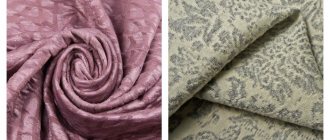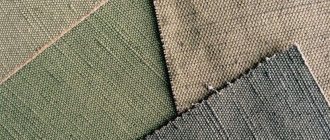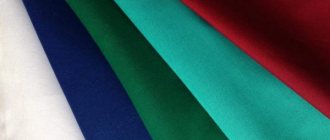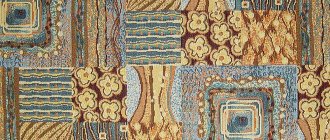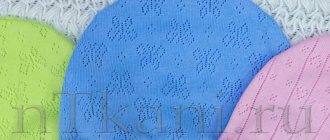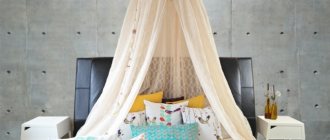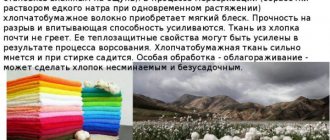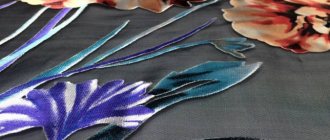A shirt is the main part of a man’s wardrobe, both everyday and for special occasions. Therefore, it is always selected carefully both in terms of quality and fashion, as well as colors and type of fabric.
There are many types of material from which shirts are made. You can purchase any at a very affordable price on the website etkani.com/product/bluzochnaya-rubashechnaya.
Most popular fabrics
- Cotton has occupied a leading position for many, many years, since our ancestors sewed shirts from it. This is a natural fabric that is environmentally friendly, has good moisture removal, is breathable, durable, and easy to iron. At the same time, you should buy a cotton shirt in a slightly larger size, because it will “shrink” after washing. And there is one more drawback - rapid wear. Now, so that the product does not have such negative aspects, viscose is used in the production of fabric along with cotton.
- Silk is a fabric for elegant shirts that looks simply luxurious. But it gets wrinkled very quickly and is difficult to iron. In addition, silk requires special care and special washing.
- Poplin is a dense material with a rough weave, but also a soft texture that is pleasant to the body. This shirt is suitable for every day, is easy to wash, and wrinkles little.
- Oxford is similar in density to the aforementioned poplin, but is stiffer, but it is no less pleasant to the touch. It is also used to make casual shirts that go with wool suits and jeans.
- Flannel is a medium-density, soft fabric containing wool or cotton fibers. As a rule, shirts are made from plaid flannel; they are warm and cozy. Its disadvantage is this: very quickly after wearing, the fibers roll off, and the product turns out untidy, as if worn out.
Summer shirts - choosing fabrics
Summer is already here, which means it's time to think about updating your wardrobe. First of all, you need to take care of the presence of men's shirts that have excellent thermoregulatory, breathable, hypoallergenic and hygroscopic abilities. What materials meet these requirements and are best suited for sewing summer men's shirts?
Optimal fabric for summer shirts
The modern textile industry offers several options for materials that are ideal for the summer heat.
Pure cotton
Cotton is one of the best fabric options for sewing summer men's shirts. This material has an impressive list of advantages:
- Hygroscopicity and hydrophilicity. The fabric easily absorbs moisture from the air, as well as evaporation from the human body (sweat). Interestingly, when wet, cotton products become more durable (unlike most other materials, the strength of which decreases when wet).
- Thermal protection. Cotton fiber has a hollow structure, due to which clothes made from it do not heat up.
- High strength. Depending on the type of cotton used to produce the material, a single fiber of fabric can withstand loads of up to 8 g. However, it must be taken into account that the density of cotton decreases as it is exposed to direct sunlight and high temperatures.
- Softness. The touch of cotton fabric to the body is very pleasant and almost imperceptible.
- Hypoallergenic. This advantage of cotton fabric is especially important for men with sensitive skin, as well as for allergy sufferers.
However, 100% cotton also has disadvantages:
- Products made from it wrinkle easily. Therefore, if you are not inspired by the prospect of walking around all day in a wrinkled shirt, it is better to pay attention to clothes made from a mixture of cotton and synthetic fiber - for example, polyester.
- Pure cotton shrinks after the first wash. The degree of shrinkage varies from 2 to 5%.
- When stored in damp areas, cotton shirts are susceptible to mold infection and subsequent rotting.
- Products made from high-quality 100% cotton are highly expensive.
Pure flax
Like cotton, 100% linen is a suitable option for sewing summer men's shirts. Its characteristics speak about this:
- Linen has the ability to reflect UV radiation, which makes items made from it indispensable in a summer wardrobe.
- This material is characterized by high hygroscopicity and thermal conductivity. For this reason, linen shirts are widespread in countries with extremely hot and humid climates.
- Linen is hypoallergenic, does not cause skin irritation, and is pleasant to the touch.
However, like pure cotton, 100% linen has some disadvantages. The most notable among them:
- Significant shrinkage when washed (especially in hot water). Because of this, linen is always moistened and dried before sewing clothes.
- Men's linen shirts wrinkle very much. Perhaps the dimensional stability of linen products is even lower than that of similar cotton items. For this reason, small amounts of synthetic threads are often added to flax fibers.
- Products made from pure linen are by no means cheap.
Denim and chambray
For sewing informal summer men's shirts, denim is used, as well as its thinner analogue - chambray fabric. Both of these materials are characterized by high density and lightness, they are highly breathable and absorb moisture. By the way, unlike pure cotton and linen, denim and chambray are much cheaper.
Fine wool
Although this material is mostly associated with cold weather, shirts made from fine wool can be a suitable option for summer. For example, clothes made of soft and pleasant to the touch flannel are an ideal solution for creating an informal look. Wool shirts allow the body to breathe, they are characterized by good shape stability and heat protection.
To obtain the so-called summer wool (cool wool), expensive Australian merino raw materials are used. This naturally follows the main disadvantage of shirts made of such material - their high cost. However, the cost of purchasing clothes made from summer wool will be recouped due to the comfort during wear.
Mixed materials
In terms of price-quality ratio, the most optimal fabric for sewing summer shirts is a mixed material. It can be cotton or linen with a small addition of polyester or lycra. By including artificial fibers in the fabric, manufacturers are able to achieve greater dimensional stability and a long service life of clothing. At the same time, the material still remains breathable and pleasant to the touch.
Summer shirts in the online store “Your Shirt”
Our online store offers men's summer shirts with short and long sleeves. Most products are made from mixed materials (cotton and polyester), due to which the products have excellent breathability and wear-resistant characteristics.
Determining quality
When choosing this part of a man's wardrobe, you should pay attention to the following details:
- the shirt should look nice - the fabric should not have a synthetic shine, but should be smooth and dense;
- clarity of the drawing;
- the collar must have an ideal design;
- The high quality of tailoring is evidenced by at least eight stitches per 1 cm, this is especially clearly visible on the collar.
As for caring for your shirt, the label on it will tell you the right way. Usually it is recommended to wash the product at temperatures up to 40 degrees, dry it on hangers, and iron it with a little dampness.
If there are stains on the cuffs and collars, they are removed using special means, of which there are now many.
It is not recommended to rub these places - this will ruin their condition. Tweet
How to choose a quality men's shirt.
A shirt is an integral part of a man's wardrobe. Every man has shirts for all occasions: to the office, to an interview, to a special event, to a meeting with partners or friends in a bar, for a crazy party in a club and even for a picnic and barbecue in the country. Depending on the situation, this shirt will be classic or casual, that is, everyday. And since a shirt is an indispensable item in a man’s look, I would like it to be of high quality and add elegance, thoughtfulness, sophistication and taste to your style.
It’s not without reason that they say, “one meets you by your clothes...” It would seem like little things like the design of buttons, straight stitches, features of fabric and tailoring, but all this makes the thing and your appearance as a whole presentable and contributes to the opinion of your personality.
In this article I would like to focus on a review of the quality of a classic mid-price shirt, but, nevertheless, I will touch on the features of premium and casual shirts.
Size and fit.
“The main thing is that the suit fits...”
The shirt should fit your size and you should feel comfortable in it.
Most often, the size of a shirt is determined by the collar. To determine the collar size you need, measure yourself with a measuring tape around the base of your neck, at the level of the pit between the neck and sternum, but do not tighten it too tightly and round up. This will be your collar size. When the collar button is fastened, a finger should pass between the neck and collar to allow freedom of movement.
Depending on the characteristics of your figure and your preferences, you should decide on the silhouette of the shirt: classic (loose), slim (fitted), super slim (very tapered).
Also, if you are tall or, on the contrary, short, have a tummy or have short or long arms, which also applies to the characteristics of your figure, then it makes sense to additionally measure the width of your shoulders, sleeve length and waist circumference. Then it is possible to buy a shirt without trying it on.
No matter how well-made a shirt is, if it has a poor fit (bad patterns), such a shirt will not look presentable. Make sure that the shoulders are “in place” and that there are no unnecessary folds at the neckline or at the armhole. The sleeve itself should not be very long or short; when the arm is in a free position, it should reach the base of the thumb. A dress shirt should be long enough to remain tucked into your pants when your arms are raised. Casual shirts are often worn untucked.
Textile.
A high-quality shirt will be made from natural fabrics, for classic and casual, these are cotton, silk and linen, or from cotton fabrics with a small addition of polyester.
There's nothing better than a classic shirt made from high-twist, long-staple cotton. Such fabric will have excellent consumer properties. The only negative is that such a shirt will wrinkle a lot (although there is also a dependence on the weave of the threads; fabrics with a weave, that is, with finely patterned weaves of threads, will wrinkle a little less). To eliminate this disadvantage of cotton, fabric for shirts is treated with a special impregnation “non iron” or “easy iron”, that is, “easy ironing”, usually manufacturers give a guarantee for this impregnation of 30-40 washes. This impregnation is most often used in premium shirts due to its additional cost.
In the mid-price segment of dress shirts, non-iron cotton or cotton fabrics with a small addition of polyester are usually used. Shirts made from fabric with a small addition of synthetics wear well, practically do not wrinkle, and are easy to iron and wash. In appearance they are indistinguishable from pure cotton. These fabrics show much less streaks and sweat stains than cotton.
In such fabrics, polyester should not contain more than 30% and the yarn in the warp and weft (transverse and longitudinal threads) should be homogeneous, that is, there should not be separate threads of polyester and cotton, and the yarn (thread) should be mixed from cotton and synthetic fibers .
“Chameleon” fabrics and fabrics with finely patterned designs look richer, but, of course, you can’t do without ordinary poplin in a men’s collection.
Casual shirts are characterized by all sorts of natural fabrics from cotton and linen, corduroy, flannel, etc., bold designs of checks, stripes and prints.
Fabric adjustment.
If the shirt uses fabric with a check, stripe or other repeating pattern, then the pattern should flow into each other at the junction of various parts, that is, it should be adjusted according to repeat. The ends of the collar, sleeves and cuffs should also be symmetrical in pattern. If there is no other designer's idea.
Buttons.
It is a priori believed that the best buttons for men's shirts are made from Australian mother-of-pearl. And premium shirts use exactly these buttons.
As for the middle class, this is mother-of-pearl plastic in various variations, sometimes with an interesting shape or with a logo.
In casual shirts, brass and coatings for various metals are more common, as well as a logo on buttons and other variety of designs. In general, everything related to casual is freedom within the framework of fashion trends.
For mid-segment shirts and below, the buttons are sewn on automatically; for premium class shirts, a “crow’s foot” is used manually, the thread is wrapped around the base of the button.
Collar.
The collar of classic shirts has a very dense, shape-resistant, but quite flexible adhesive that does not deform when washing and wearing the product.
High-quality dress shirts must have removable plastic bones.
Casual shirts usually have a thin soft glue in the collar.
Other technological features.
Seams.
A high-quality shirt should have uniform, even stitches and the number of stitches per 1 cm should not be less than 6-8. The more often the stitch, the more painstaking the work and the stronger the seams. This rule applies to classic shirts; in casual shirts, decorative stitches with thick thread and wide stitch are often found.
In premium shirts, some seams and finishing are done by hand. Of course, a “live seam” is more elastic and makes the fit more natural, but it usually goes in tandem with a machine seam, since machine stitching is still stronger. But in this case, the machine seam is made with one needle, which cannot be said about shirts in the middle price segment, where the main seams are made with a two-needle machine.
What else makes the shirt look elite is the sleeve, which is sewn on after the back and front are sewn. It’s easy to determine: see if the side seam and the inner seam of the sleeve match. If not, the sleeve is sewn on at the end.
The quality of the shirt is also indicated by the thin, neat, even and unstretched hem at the bottom.
Loops.
The stitching of the loops should be tight and even, the loop should be well cleaned without protruding threads. In luxury shirts, the buttonholes are hand-stitched, thereby making the buttonhole more elastic and durable.
You also need to make sure that the loops lie evenly on the buttons, that there are no bubbles or unnecessary folds either in the fastener area or in the product as a whole.
In conclusion, I would like to say that it is pleasant for any person to hold a quality item in their hands, because it is akin to a work of art on which more than one person worked, and even more so to wear such a product and, as they say, to bring culture to the masses.
We hope you found this article useful.
Be beautiful and successful!
P. _ S .: MSQ shirts meet all quality standards.
Shirt cut
Most people buy shirts that don't fit their proportions. The problem is that ready-made shirts are made to fit one size fits all. As a result, they are not suitable for anyone. And compromises have to be made. If the shirt fits at the collar, it does not fit at the sleeve length. If the sleeve fits well, it dangles around the stomach. The ideal is achieved either by tailoring to order, or by meticulousness in choosing and searching for exactly what we need. To find the right men's shirt, follow these simple tips.
A good shirt should be, above all, comfortable. This is the most important rule. Bigger people tend to choose looser shirts. While petite and thin people opt for models that better emphasize the body.
In general, the shirt should:
- Fit two fingers between neck and collar when fully buttoned.
- It fits tightly enough around the wrist so that the shirt can only be removed with the cuffs undone.
- Have long enough sleeves. Such that you can raise your arms without stretching your forearms; but they should be short enough so that the fabric bunches up no more than 1cm at the cuffs when your arms are down.
- Shoulders should be strictly in place.
- Your torso shouldn't shoot out your shirt buttons if you decide to stretch. And at the same time, the shirt should not act as a sail.
- The edge of the cuff should not protrude more than 1.5 cm from under the jacket.
Shirting fabric: types, characteristic features
Shirts are convenient and comfortable clothing, present in men's and women's wardrobes. This type of product goes well with trousers, skirts, and shorts. Therefore, you can wear them to work, to informal events and for a walk. To make a shirt fit the moment, you need to choose the right style, fabric, and color.
Shirt fabric: features, characteristics
The materials from which products in direct contact with the body are made are subject to increased demands. They have to:
- have good breathability;
- be pleasant to the touch;
- have sufficient wear resistance.
Both natural fabrics and mixed materials with a permissible amount of artificial components in the composition meet these criteria.
Fabrics for shirts: assortment of the Tekstil-Kontakt store
If you need high-quality fabric for a shirt for sewing, you can select it from a catalog on the Textile Contact store website. Here shirt fabric is represented by the following types:
- Flannel is a soft fabric. It is used in sewing warm shirts, which reliably protect the body from hypothermia in cold weather. You can wear a product made of plain fabric to work or school; checkered fabric is popular in everyday style. A loose-fitting flannel shirt worn over a T-shirt looks attractive on a man.
- Oxford is a dense, high-quality material made from a special type of weaving - twill (“matting”). Thanks to the group weave of dyed and undyed threads, the fabric has a distinct checkerboard texture and is not monochromatic. The matting shirt fabric goes well with informal jackets and casual trousers.
- Poplin is a smooth, dense fabric. Thanks to this texture, poplin shirts fit well. The beautiful pattern of the fabric, with a small rib, obtained by special weaving of threads, gives the product an attractive appearance. Shirts made of poplin in solid colors go perfectly with formal jackets and business suits. Look for this fabric for a shirt on the website of our online store.
Crinkled cambric, linen, viscose are well-ventilated fabrics used for sewing light shirts and other sets of summer clothing.
Padding materials in the online store
To ensure that such clothing details as collars and cuffs look beautiful, and that the trims do not stretch out when worn and washed, cushioning materials are used in sewing shirts. Nonwoven fabric is a non-woven material with sizing. Dublerin is a fabric with an adhesive coating and a clearly defined grain thread, which must be taken into account when cutting. By visiting the website tk.ua/ru/catalog/vse-tkani/dublirin-flizelin.html, you can buy them in the Textile Contact online store.
In contact with
News MirTesen

